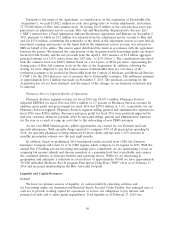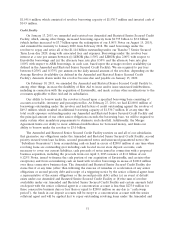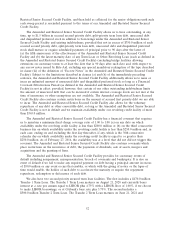Rite Aid 2016 Annual Report Download - page 59
Download and view the complete annual report
Please find page 59 of the 2016 Rite Aid annual report below. You can navigate through the pages in the report by either clicking on the pages listed below, or by using the keyword search tool below to find specific information within the annual report.Goodwill Impairment: Our policy is to perform an impairment test of goodwill at least annually,
and more frequently if events or circumstances occurred that would indicate a reduced fair value in our
reporting units could exist. We perform a qualitative assessment in the fourth quarter of the fiscal year
to determine if it is more likely than not that the carrying value of the goodwill exceeds the fair value
of the goodwill. During our qualitative assessment we make significant estimates, assumptions, and
judgments, including, but not limited to, the overall economy, industry and market conditions, financial
performance of the Company, changes in our share price, and forecasts of revenue, profit, working
capital requirements, and cash flows. We consider each reporting unit’s historical results and operating
trends when determining these assumptions; however, our estimates and projections can be affected by
a number of factors and it is possible that actual results could differ from the assumptions used in our
impairment assessment. If we determine that it is more likely than not that the carrying value of the
goodwill exceeds the fair value of the goodwill, we perform the first step of the impairment process,
which compares the fair value of the reporting unit to its carrying amount, including the goodwill. If
the carrying value of the reporting unit exceeds the fair value, the second step of the impairment
process is performed and the implied fair value of the reporting unit is compared to the carrying
amount of the goodwill. The implied fair value of the goodwill is determined the same way as the
goodwill recognized in a business combination. We assign the fair value of a reporting unit to all of the
assets and liabilities of that unit (including unrecognized intangible assets) and any excess goes to the
goodwill (its implied fair value). Any excess carrying amount of the goodwill over the implied fair value
of the goodwill, is the amount of the impairment loss recognized.
Impairment of long-lived assets: We evaluate long-lived assets for impairment whenever events or
changes in circumstances indicate that an asset group has a carrying value that may not be recoverable.
The individual operating store is the lowest level for which cash flows are identifiable. As such, we
evaluate individual stores for recoverability. To determine if a store needs to be tested for
recoverability, we consider items such as decreases in market prices, changes in the manner in which
the store is being used or physical condition, changes in legal factors or business climate, an
accumulation of losses significantly in excess of budget, a current period operating or cash flow loss
combined with a history of operating or cash flow losses or a projection of continuing losses, or an
expectation that the store will be closed or sold.
We monitor new and recently relocated stores against operational projections and other strategic
factors such as regional economics, new competitive entries and other local market considerations to
determine if an impairment evaluation is required. For other stores, we perform a recoverability
analysis if they have experienced current-period and historical cash flow losses.
In performing the recoverability test, we compare the expected future cash flows of a store to the
carrying amount of its assets. Significant judgment is used to estimate future cash flows. Major
assumptions that contribute to our future cash flow projections include: expected sales and gross profit,
pharmacy reimbursement rates, expected costs such as payroll, and estimates for other significant
selling, general and administrative expenses.
If an operating store’s estimated future undiscounted cash flows are not sufficient to cover its
carrying value, its carrying value is reduced to fair value which is its estimated future discounted cash
flows. The discount rate is commensurate with the risks associated with the recovery of a similar asset.
We regularly approve certain stores for closure. Impairment charges for closed stores, if any, are
evaluated and recorded in the quarter the closure decision is approved.
We also evaluate assets to be disposed of on a quarterly basis to determine if an additional
impairment charge is required. Fair value estimates are provided by independent brokers who operate
in the local markets where the assets are located.
59
























